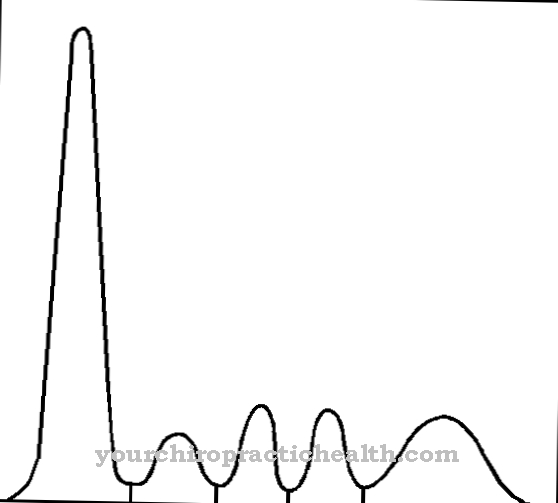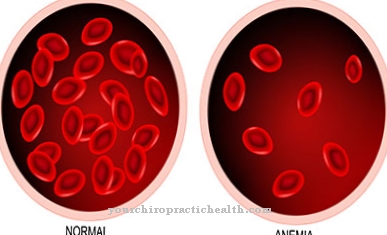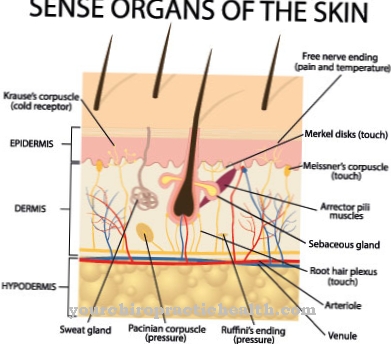A Leg length difference is characterized by an acquired or congenital difference in length of the lower extremities (legs). About 40 to 75 percent of the population are affected by a difference in length of the legs, which, however, only becomes clinically relevant from 1 to 2 centimeters.
What is a leg length difference?

© Catalin Pop - stock.adobe.com
A difference in length between the two lower extremities is called a leg length difference. In general, a distinction is made between a real or anatomical and functional leg length difference.
While the anatomical difference in leg length is caused by a real difference in length of the leg bones, a functional difference in length is primarily caused by contractures of the joints, the capsular ligament apparatus or the muscles as well as malpositions of the hip joint.
As a rule, a minimal difference in leg length does not lead to any complaints, but it can cause a compensatory spinal curvature or a shortened limp. A more pronounced difference in leg length causes a change in the statics of the musculoskeletal system, which is not infrequently associated with pelvic obliquity and / or scoliosis (lumbar scoliosis, cervicothoracic scoliosis).
In addition, equinus foot posture, intervertebral disc wear, osteophyte formation and spondylarthrosis can be observed with a leg length difference.
causes
The anatomical difference in leg length is usually due to congenital malformations as a result of congenital growth disorders of the lower extremities (osteochondrodysplasias), which are found in the epiphyses (growth plates), metaphyses (long bone section between the epiphysis and the shaft), in the periosteum (periosteum) and / or endosteum (inner Periosteum) and can lead to unilaterally reduced bone growth.
In addition, tumors (neurofibromatosis Recklinghausen; enchondromatosis, osteochondromatosis), tumor-like diseases (fibrous dysplasia) and (a) septic inflammations (osteomyelitis, juvenile polyarthritis) can cause a leg length difference via a reduction in bone mass.
Neuro-orthopedic diseases such as poliomyelitis (polio) can also induce shortening of the legs through insufficient mineralization of the bones. Functional length differences in the legs, on the other hand, are due to genetic or traumatic dislocations (sprains) or contractures of the knee, hip or upper ankle joints.
Symptoms, ailments & signs
The different lengths of the legs themselves are often invisible to the naked eye and primarily do not cause any discomfort. The complaints and their symptoms arise from the asymmetry in the body and especially in the musculoskeletal system. In this way, different muscle groups, tendons and joints are stressed to different degrees, which sooner or later can lead to one-sided overload and pain.
External signs of a leg length difference can be a crooked posture, general postural problems or a crooked pelvis.These factors are usually clearly visible, but as long as there are no symptoms, they are rarely examined for their causes. Differences in leg length are also noticeable in the wear and tear of street shoes.
Usually one of the shoes has worn off more than the other, especially in the ball area and in the heel area. If you compare the heels of a pair of shoes with each other, it is often noticeable that the two shoes have different abrasion patterns.
If the difference in leg length is greater than 2.5 centimeters, symptoms can arise even when sitting for a long time, as the legs are supported on the floor with different amounts of force. Here, too, the person concerned often takes a relieving posture and bends the upper body far forward. This misalignment is very easy to see and diagnose.
Diagnosis & course
A leg length difference is usually diagnosed by clinical or manual measurement of the lower extremities while sitting, standing and lying down. An examination of the pelvis and spine enables statements to be made about structural changes as a result of compensatory adjustment processes.
With the help of nomograms, the expected difference in length and postoperative bone growth can be predicted and graphically represented in those affected who are still in the growth phase. The diagnosis is confirmed by imaging procedures. In this way, differences in length can be determined with comparative accuracy using radiographs (including standing leg images) and computer tomography.
As part of a sonographic leg length determination, the joint gaps can be localized using distance markers and the lengths of the tibia and femur can be determined. With an early prognosis and start of therapy, both forms of leg length difference have a good prognosis and a good course. However, if left untreated, a difference in length of the legs can lead to pelvic obliquity and scoliosis.
Complications
As a rule, differences in leg length are only medically important if the difference between the legs is greater than two centimeters. Minor differences do not lead to complications and are usually not treated. Most of the time, the person concerned cannot simply do everyday things because, for example, normal standing is no longer possible.
This can be counteracted by using insoles in shoes and is mainly used for smaller leg length differences. If the leg length difference is more pronounced, the shoes can be prepared orthopedically so that the leg length difference is compensated for. Otherwise there are no further complications.
Due to the difference in leg length, the patient's growth is often severely restricted. This leads to a short stature in many of those affected. This can have a negative effect on the psyche, especially in childhood, as children are often bullied for it. The difference in leg length itself can also lead to psychological problems and reduced self-esteem.
Treatment of the symptom itself is not possible. However, it makes sense to identify the leg length difference in early childhood, as operations can be carried out here that accelerate growth and thus compensate for the differences.
When should you go to the doctor?
The greater the difference in leg length, the more important the treatment. Minimal differences do not lead to complaints or only occasionally. In this case, targeted gymnastics or an over-the-counter sales increase helps. If there is persistent pain in the hip, pelvis or lumbar spine, treatment by an orthopedic doctor is necessary. Only he is able to diagnose the leg length difference and its effects on the skeletal system.
The pediatrician is the first point of contact for babies and toddlers. He will determine if there is a leg length difference during the preventive examinations and initiate immediate therapy. In most cases, the little ones no longer have any symptoms in adulthood.
If the difference occurs after trauma, immediate treatment is necessary. This is the only way to minimize or eliminate permanent damage. Diseases that affect the musculoskeletal system can lead to pelvic inclination. Even then, treatment by a specialist is necessary. The therapy is geared towards the underlying disease and its consequences.
Doctors & therapists in your area
Treatment & Therapy
The therapeutic measures depend on the extent of the specific leg length difference. For example, differences in length of up to one centimeter generally do not require any therapy if there are no symptoms. To compensate for the difference, shoe insoles or adjustments on the ready-to-wear shoe (heel cushions, heel wedges) are used.
Differences in length of no more than three centimeters can be compensated for with the help of an orthopedic shoe adjustment (heel heel with sole compensation). If there are more pronounced differences in length (from 3 cm), orthopedic custom-made shoes or custom-made shoes with inner shoes or footbed orthoses are recommended. In addition, a difference in length of up to 12 centimeters can be compensated for by using inner shoes that bring the foot of the shorter leg into an equinus position and have adapted heel rollers.
If there is a significant difference in leg length, floor shoes or orthopedic leg orthoses, through which the foot is fixed on a synthetic foot in the equinus position, are possible. In the context of surgical interventions that are considered in the event of an anatomically determined difference of not less than 3 centimeters, compensatory measures can generally be shortened or lengthened.
The temporary clamping or permanent sclerotherapy of not yet closed epiphyses to reduce the growth of the affected bone (epiphysodesis) is a comparatively simple standard procedure for those affected whose growth phase has not yet been completed.
In addition, after completion of the growth phase, the longer extremity can be shortened osteotomically or the shorter one can be lengthened by an external fixator or an intramedullary nail. Functional leg length differences should also be treated causally in order to largely eliminate the triggering factor.
Outlook & forecast
The prognosis of a leg length difference depends on various factors. First of all, it is important to take precise measurements in order to distinguish an anatomical difference in leg length from a functional one, since an anatomical difference in leg length is treated differently than a functional one. In the case of a functional one, for example, raising the shoes would do more harm than good.
The spine can usually compensate for a difference of less than 2 cm, but beyond that, the prognosis depends on the earliest possible treatment. If the pelvic obliquity due to a different leg length is not treated, it can lead to back pain and a curvature of the spine (scoliosis).
If the shortening of the leg can already be treated with suitable measures during the growth phase, the prognosis is good and in most cases no surgical intervention is necessary. When prescribing shoe insoles or increases, the prospect of improvement is positive if they are worn regularly.
If a shortened leg is diagnosed later, the outlook depends on whether the unequal load has caused long-term wear and tear on the joints. Usually, in addition to treating the leg length difference, physiotherapeutic measures are also necessary to relieve muscle tension and overloading the joints. The longer the leg length difference, the greater the risk of osteoarthritis due to joint wear.
prevention
As a rule, a congenital anatomical difference in leg length cannot be prevented. Since surgical adjustment in the growth phase is associated with fewer complications, the difference in length should be diagnosed at an early stage. Secondary leg length differences can, if necessary, be prevented through consistent treatment of the underlying disease.
Aftercare
If the hip is inclined, compensation can be created manually. In this case, no follow-up care is required. After adjusting insoles or heel cushions or adjusting the shoe sole, the leg length difference can be compensated for. Aftercare ensures that it is sufficient and that the walk can run correctly. It must be checked at regular intervals whether the measures taken still sufficiently compensate for the leg length difference.
Surgical measures are also conceivable for the leg length difference. As expected, follow-up care must be carried out more frequently and with greater care. If pain occurs, follow-up care must be particularly careful. The cause of the pain needs to be identified or eliminated. If the leg length discrepancy occurred after the insertion of a hip prosthesis, follow-up care must ensure that it is rectified as quickly as possible.
Even small differences in leg length can trigger a crooked hip. Therefore, preventive measures include informing the patient about possible leg axis shifts. He needs to know that these are not always avoidable and that they can be compensated for in aftercare. Follow-up care is also so important because the operated patient can claim compensation for pain or leg length differences that he has not been adequately informed about.
You can do that yourself
In the case of a leg length difference, suitable therapeutic measures should always be worked out in collaboration with a doctor. The complaints associated with legs of different lengths can, however, also be reduced through self-help measures and some home remedies.
A slight difference can often be compensated for with special shoes. In the event of major differences, medical clarification should be carried out as soon as possible. The faster the leg length difference is recognized, the sooner a suitable treatment can be started.
This can often prevent malpositions and other complaints. Physiotherapeutic measures and sporting activity help against any back and hip pain that may already have arisen. In particular, targeted fascia training and yoga exercises such as the pigeon help to strengthen the "weak" leg and compensate for misalignments.
People with a leg length difference should also follow a healthy lifestyle. A fit musculoskeletal system on the one hand and a strong immune system on the other hand help against pain in the long term and prevent psychological complaints. If psychological or physical symptoms have already set in, a therapist must be called in. In general, acceptance and an open approach to leg length differences are important for recovery.


.jpg)
























